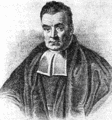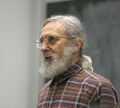Template:Selected anniversaries/April 7: Difference between revisions
No edit summary |
No edit summary |
||
| Line 1: | Line 1: | ||
<gallery> | <gallery> | ||
||529: First draft of the Corpus Juris Civilis (a fundamental work in jurisprudence) is issued by Eastern Roman Emperor Justinian I. | ||529: First draft of the ''Corpus Juris Civilis'' (a fundamental work in jurisprudence) is issued by Eastern Roman Emperor Justinian I. Pic: Justinian. | ||
||1658: Juan Eusebio Nieremberg dies ... mystic and philosopher. No DOB. Pic. | ||1658: Juan Eusebio Nieremberg dies ... mystic and philosopher. No DOB. Pic. | ||
||1727: Michel Adanson born ... botanist, entomologist, and mycologist. | ||1727: Michel Adanson born ... botanist, entomologist, and mycologist. Pic. | ||
File:Thomas_Bayes.gif|link=Thomas Bayes (nonfiction)|1761: Mathematician, philosopher, and minister [[Thomas Bayes (nonfiction)|Thomas Bayes]] dies. He is remembered for having formulated a specific case of the theorem that bears his name: Bayes' theorem. | File:Thomas_Bayes.gif|link=Thomas Bayes (nonfiction)|1761: Mathematician, philosopher, and minister [[Thomas Bayes (nonfiction)|Thomas Bayes]] dies. He is remembered for having formulated a specific case of the theorem that bears his name: Bayes' theorem. | ||
||1789: Petrus Camper dies ... physician, anatomist, and physiologist. | ||1789: Petrus Camper dies ... physician, anatomist, and physiologist. Pic. | ||
File:Joseph_Fourier.jpg|link=Joseph Fourier (nonfiction)|1789: Mathematician and physicist [[Joseph Fourier (nonfiction)|Joseph Fourier]] uses early version of Fourier series analysis to detect and prevent [[crimes against mathematical constants]]. | File:Joseph_Fourier.jpg|link=Joseph Fourier (nonfiction)|1789: Mathematician and physicist [[Joseph Fourier (nonfiction)|Joseph Fourier]] uses early version of Fourier series analysis to detect and prevent [[crimes against mathematical constants]]. | ||
Revision as of 07:20, 28 February 2019
1761: Mathematician, philosopher, and minister Thomas Bayes dies. He is remembered for having formulated a specific case of the theorem that bears his name: Bayes' theorem.
1789: Mathematician and physicist Joseph Fourier uses early version of Fourier series analysis to detect and prevent crimes against mathematical constants.
1811: Astronomer, mathematician, and philosopher Hasan Tahsini born. He will become one of the most prominent scholars of the Ottoman Empire of the 19th century.
1860: Physicist and crime-fighter Ernst Ruhmer invents a camera which uses the light-sensitivity properties of selenium to record images from past and future events. This type of camera is popular with math photographers, notably Cantor Parabola.
1866: Mathematician Erik Ivar Fredholm born. He will introduce and analyze a class of integral equations now called Fredholm equations. Fredholm's work on integral equations and operator theory will anticipate the theory of Hilbert spaces.
1867: Gem detective Niles Cartouchian works with Hasan Tahsini to recover stolen shipment of time crystals (nonfiction).
1889: Mathematician Paul David Gustav du Bois-Reymond dies. He worked on the theory of functions and in mathematical physics.
1899: Physicist and academic Petrus Leonardus Rijke dies. He explored the physics of electricity, and is known for the Rijke tube (which turns heat into sound, by creating a self-amplifying standing wave).
1995: Mathematician and crime-fighter Donald Erik Sarason combines Hardy space theory with Vanishing mean oscillation (VMO); in the process, he will discover radical new techniques for detecting and preventing crimes against mathematical constants.
1995: Math photographer Cantor Parabola takes a series of photographs which capture temporal superimpositions from physicist and academic Petrus Leonardus Rijke in the form of a self-amplifying standing wave.
2009: Game designer Dave Arneson dies. He co-created the pioneering role-playing game Dungeons & Dragons with Gary Gygax.









